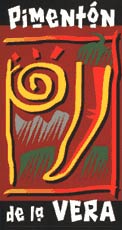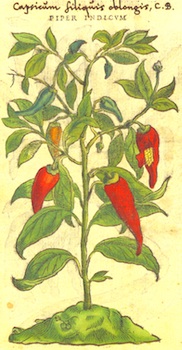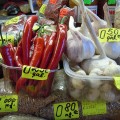by Dave DeWitt
Recipe Index
Spanish Chorizo with Pimentón
Pimentón Garlic Soup
Grilled Tuna Steaks with Salsa Pimentón
Everyone knows that Columbus carried chile peppers to Spain from the New World on his second voyage in 1493, but who first used the pods for flavoring food? José Guerra, writing in “Foods from Spain News,” speculates that monks at the Monastery of Guadalupe in Extremadura were the first Europeans to discover the flavor–and heat–of chiles by crushing them and adding them to their soups. This theory agrees with that of food historians, who believe that chiles initially were grown in monasteries and the seeds were spread throughout Spain and Europe first by traveling monks and then by Spanish and Portuguese traders, who introduced them into Africa, India, and Asia. Within a hundred years after Columbus brought them to Spain, chile peppers had circumnavigated the globe and spiced up numerous regional cuisines.
But what happened to the chiles in Spain? Why didn’t the cuisine of Spain become fired up like that of India, or even Hungary? No one knows for certain. As in Italy, there are a few hot and spicy dishes in Spain, but chiles did not dominate the cuisine–except in one part of Extremadura in the far west, the same region where they were first introduced. That hotbed of chiles is the valley of La Vera, where the pimientos (chiles) are grown and smoked to make the famous spice pimentón de la Vera.
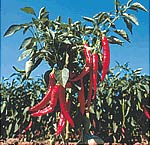 |
Pimiento Pods |
Some sources speculate that the pimentón tradition in La Vera was started by another group of monks from the Yuste Monastery in Caceres in the sixteenth century. According to Janet Mendel, author of Traditional Spanish Cooking, when the Spanish emperor Charles V abdicated the throne of Spain in 1555 and retired to the Yuste monastery, he loved pimentón immensely. He recommended it to his sister, Queen Mary of Hungary, and that is how paprika became popular in that country. (Other sources give credit to the Turks for introducing chiles into Hungary at a later date.)
The Yuste monks, over the centuries, shared their secrets of growing and processing the chiles with local farmers. But it wasn’t until the mid-nineteenth century that the farmers began growing their pimientos on a large scale and processing them into pimentón. These days, pimentón is the region’s main source of income.
Growing and Smoking the Pimientos
In early March, farmers germinate the seeds and grow seedlings in greenhouses. They are transplanted to the fields in May. Some of the fields are so remote that they are not accessible to tractors and other farm equipment, so farmers use mule labor to prepare the fields, and ride mules to the fields to remove weeds by hand. In all the fields, the crop is picked by hand in October when all the pods are bright red but still pliable. In eastern Spain, where it is drier, the pods can be dried in the sun. But in Extremadura, fall rains raise the humidity to the level where the pods would rot or mold. So in the La Vera valley, they are placed in burlap sacks and then loaded on flatbed trucks that haul them to the drying buildings.
 |
Long dried and smoked pimiento |
The pimientos are slowly dried over smoldering pedunculate or holm oak logs for ten to fifteen days and are hand-turned twenty-four hours a day before they are ready to be processed into pimentón. The smoke-dried pods are then ground into powder (the pimentón) and packed in bulk containers. The majority of the pimentón goes to the sausage factories, where it is used to spice up, flavor, and brighten up the famous Spanish chorizo. But it is also packed in tins for the consumer market. There are three varieties of pimentón–sweet (dulce), hot (picante), and bittersweet (agridulce).
 |
Grinding Machines in a |
Pimentón de la Vera was the first chile pepper product to be granted a Denominacíon de Origen, or controlled name status. (The second was the piment d’Espelette, which was granted a French Appellation d’Origine Controlee). Controlled name status means that other varieties of pimientos cannot be called pimentón, and that consumers are guaranteed that the product is made in the same, time-honored manner. Look for the letters “D.O.” on any product labeled as pimentón.
Culinary Uses
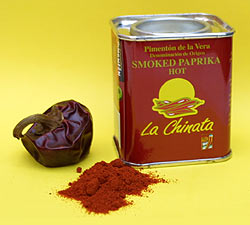 |
Pimentón de La Vera |
Sweet pimentón is great for flavoring potatoes, rice, and fish recipes, while the traditional bittersweet, smoky variety is used as a flavoring for smoked meats and in beans, game dishes, and stews. The hot type is used in winter soups, chorizo, and Galician pulpo, or octopus. The octopus is boiled and sliced, then sprinkled with olive oil, salt, and hot pimentón powder. Interestingly, there are recipes for chorizo and potato stews that utilize all three of the types of pimentón. Substitutions for pimentón include hot paprika and New Mexican ground red chile, but for a better approximation of the smokiness of the pimentón, mix in some ground chipotle chile.
Conversely, hot pimentón can be substituted for any recipe calling for paprika or ground red chile. Chili con carne enthusiasts should experiment with pimentón in their never-ending quest to improve their chili.
Resources
Pimentón may be found in markets selling Iberian and Latino foods. It is available by mail order from the following websites: www.spaincuisine.com
In Europe, especially in the German-speaking countries, Pimentón de La Vera is available at the Pepperworld Hot Shop:
Pimentón Recipes
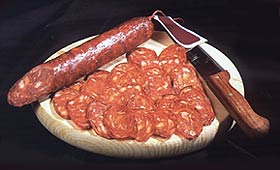
This is the classic Spanish sausage which was later transplanted to Mexico and flavored with different chiles. Traditionally, the links are air-dried in a cool place before being refrigerated. For a great breakfast treat, remove the sausage from the casings, crumble and fry it in a pan. Add eggs that have been whisked and scramble them with the sausage. Serve with a chile sauce made from pimentón. You will need a sausage stuffer attachment for your grinder for this recipe. In some versions of this recipe, other seasonings, such as cinnamon and coriander, are added.
-
2 pounds lean pork, coarsely ground
-
3 cloves garlic, mashed in a press
-
1/4 cup vinegar
-
1 teaspoon oregano
-
1/4 cup hot pimentón
-
1 teaspoon freshly ground black pepper
-
2 teaspoons salt
-
1/4 teaspoon ground cumin
-
1 teaspoon oregano
-
1 yard sausage casing
In a large bowl, combine all ingredients. Using the sausage stuffer, force the mixture into the casings and twist off links and tie them.
Yield: About 2 pounds
Heat Level: Medium
Pimentón Garlic Soup
The traditional, quick garlic soup of Madrid is transformed into a smoky-hot masterpiece with the addition of pimentón. What a perfect dish for a Sunday brunch!
-
1/4 cup olive oil
-
2 ounces diced bacon
-
6 cloves garlic, diced
-
1 ½ tablespoons hot pimentón
-
1/4 teaspoon ground cumin
-
6 cups homemade chicken broth
-
Salt to taste
-
20 baguette slices, ½ inch thick and toasted
-
4 eggs
Heat the olive oil in a large soup pot over medium heat. Add the bacon and garlic and fry for about 3 minutes. Add the pimentón, cumin, and broth. Add salt to taste. Bring the mixture to a boil, then reduce the heat. Add the baguette slices and simmer for 5 minutes. Break each egg into the soup so that it rests on top. Cover the pot and cook until the whites are set but the yolks are still liquid, about 4 minutes. Carefully ladle the soup and eggs into bowls and serve.
Serves: 4
Heat Scale: Medium
Grilled Tuna Steaks with Salsa Pimentón
In this seafood specialty, the pimentón is used in the marinade and in the sauce that seasons it at serving. Salmon steaks or the steaks of any large fish may be substituted. Serve with a Caesar salad and saffron rice.
-
2 tablespoons olive oil
-
3 tablespoons hot pimentón
-
Salt and pepper to taste
-
2 tablespoons chopped fresh Italian parsley
-
4 tuna steaks, 1-inch thick
-
6 cloves garlic, minced
-
1 medium purple onion, chopped
-
2 medium tomatoes, chopped
-
2 red bell peppers, roasted, peeled, seeded, and chopped
-
½ cup minced green olives
-
Italian parsley leaves for garnish.
In a small bowl, combine 1 tablespoon of the olive oil, 1 tablespoon of pimentón, salt and peppers, and the parsley and mix well. Rub this mixture over each side of the tuna steaks. Cover the steaks and marinate for 1 hour.
Heat the remaining olive oil in a saucepan and add the garlic, onion, another tablespoon of pimentón and saute for about 2 minutes. Add the tomatoes and bell peppers and cook until the mixture thickens, about 5 minutes. Remove from the heat and transfer to a blender or food processor. Add the remaining pimentón and the olives and puree. Transfer the sauce back to the pan and keep warm.
Grill or broil the tuna steaks to the desired doneness. Serve covered with the sauce and garnished with the parsley leaves.
Serves: 4
Heat Scale: Medium

